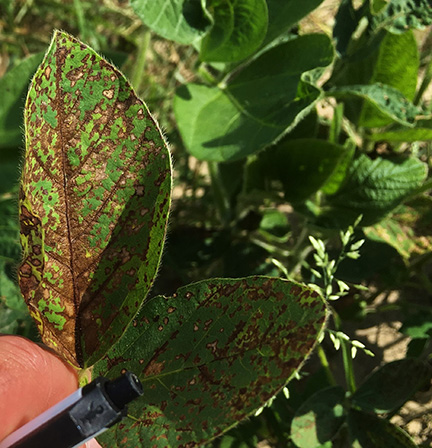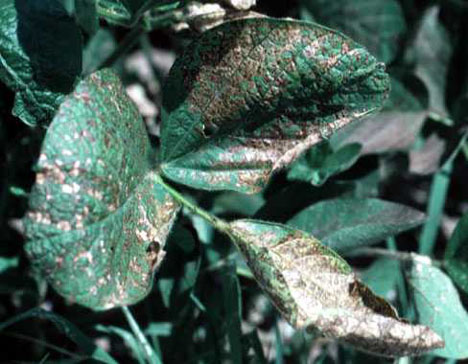Recently there has been a number of calls and samples submitted to the Purdue Plant Pest Diagnostic Lab (PPDL) worried that they have frogeye on soybean. I know due to the issues we saw at the end of last season there is a bit of concern about managing frogeye. The current weather has led to a difficult start and if you have been successful in getting soybeans in the ground there is the worry about keeping them healthy.
Plant damage can be caused by either biotic (living) agents or abiotic (non-living) agents. It is important to determine the cause of the plant damage in making management decisions. Biotic agents will include all our plant pathogens (fungi, viruses, nematodes, bacteria) and insects. Abiotic agents can include soil nutrition, drought, lightening, improper cultural practices and chemical injury (herbicide, fertilizer solutions, or adjuvants).
There are four questions to consider when you are scouting your fields and you run across plant damage. (These will be the questions we will ask when receiving a sample or image of a plant with damage.)
- Is there a pattern to the damage?
- Where is this issue in the field?
- Where is the issue on the plant? All or just a few individual plants?
- Is there progression of damage? Do you see one type of damage or does the damage vary? Is it spreading or look to be a single event?
- What plants are affected? Just the crop or surrounding weeds species? Or both?
- Are there any insects or insect feeding injury?
Most of field crop diseases will tend to cause random, irregular patterns in a field when found early. The damage should show stages of progression and look to be spreading. Generally, only the host crop will be affected and not surrounding weed species. These are broad generalizations and each pathogen will have its own distinctive characteristics, but this is a starting point for determining if there is a biotic vs. abiotic issue. If the problem is uniform or showing a pattern in the field or on the plant, and multiple plant species in a field are affected then that will lead us towards an abiotic cause such as herbicide injury.
As a reminder, there are three things needed for disease to occur 1) susceptible host, 2) viable and virulent pathogen inoculum, and 3) favorable environment.
Frogeye leaf spot is caused by the fungus Cercospora sojinia. The fungus survives overwinter on infested crop debris. Fields most at risk are those planted to susceptible varieties, those that had soybeans last year with frogeye issues with continuous soybean or short rotation, and fields under conservation tillage. Both wind and splashing water can move spores in a field and infect new plants. In addition, wind may also disperse the spores to nearby fields. Initial disease symptoms of frogeye will appear on the upper leaf surfaces as small, dark, water soaked lesions (spots) (figure 2A). These will enlarge and become round and angular with the characteristic gray to tan center with a red-purple border (figure 2B). The lesions may also have a light green or yellow halo.
Generally we do not worry about frogeye until after flowering (R1 stage), to make a decision about fungicide application. All stages are susceptible and can be infected. Frogeye is most severe when there are high moisture, humid conditions and warm temperatures (77-86 F). We definitely have had the moisture, but I’m not sure we’ve had the heat. I would suggest continue to scout and keep a close eye. Frogeye can impact yield with early disease outbreaks or just after flowering and if this disease is active a fungicide application at R3 may be warranted.

Figure 2: A – A few small lesions of frogeye. B – Multiple lesions of frogeye with variable lesion development from small to large lesions. All showing classic tan center and red-purple border.
There are a few herbicides that can mimic frogeye symptoms.
These herbicides include saflufenacil (Sharpen, and others), fomesafen (Flexstar and others), lactofen (Cobra and others), acifluorfen (Blazer and others), and paraquat (Gramoxone and others). See the Figures 3 to 9 for characteristic symptoms from each of these herbicides.
Saflufenacil is only labeled for pre-plant or pre-emergence use. Injury from saflufenacil typically occurs when the soybeans are just emerging or in the unifoliate stage, and a rainfall event causes herbicide residues to be splashed onto the young tender stems, cotyledons, and unifoliate leaves (Figures 3 and 4).
Fomesafen can be used pre-emergence and postemergence in soybean. We rarely see injury from pre-emergence use. However, since it is a contact herbicide, injury from post emergence use is fairly common and symptomology is shown in Figures 5 and 6. This type of injury does not cause any impact on yield. Injury symptoms are typically more pronounced when this herbicide is applied in hot humid weather. (Figure 6).

Figure 6. Soybean injury in response to fomesafen (Flexstar) applied under hot and humid conditions.
Lactofen and acifluorfen are labeled for postemergence use in soybeans and injury symptoms are shown in Figures 7 and 8. Much like fomesafen, this type of injury does not cause any impact on yield. Injury symptoms are typically more pronounced when this herbicide is free in the hot humid weather.
Paraquat is labeled for preplant use as a burn down herbicide. Injury symptoms are shown in figure 9 and this might be the herbicide injury symptoms that are most easily confused with frog eye. Typically we will see a red edge around the necrotic spots on the leaves. (Figure 9).
The reality of the matter is at this point in the growing season, with our delayed planting dates statewide, most likely we are not seeing injury symptoms yet from fomesafen, lactofen, or acifluorfen. we have however received calls and samples that had saflufenacil and paraquat injury symptoms.
The unique conditions will probably cause us to see new and unexpected issues, we will try to keep you informed. Due to last season I expect there to be a high inoculum pressure and we need to be vigilant in our scouting. I commend those that are out there now, sending samples and contacting us – keep it up as we don’t know what direction this season will take.
Other resources
https://crop-protection-network.s3.amazonaws.com/publications/cpn-1017-frogeye-leaf-spot.pdf









